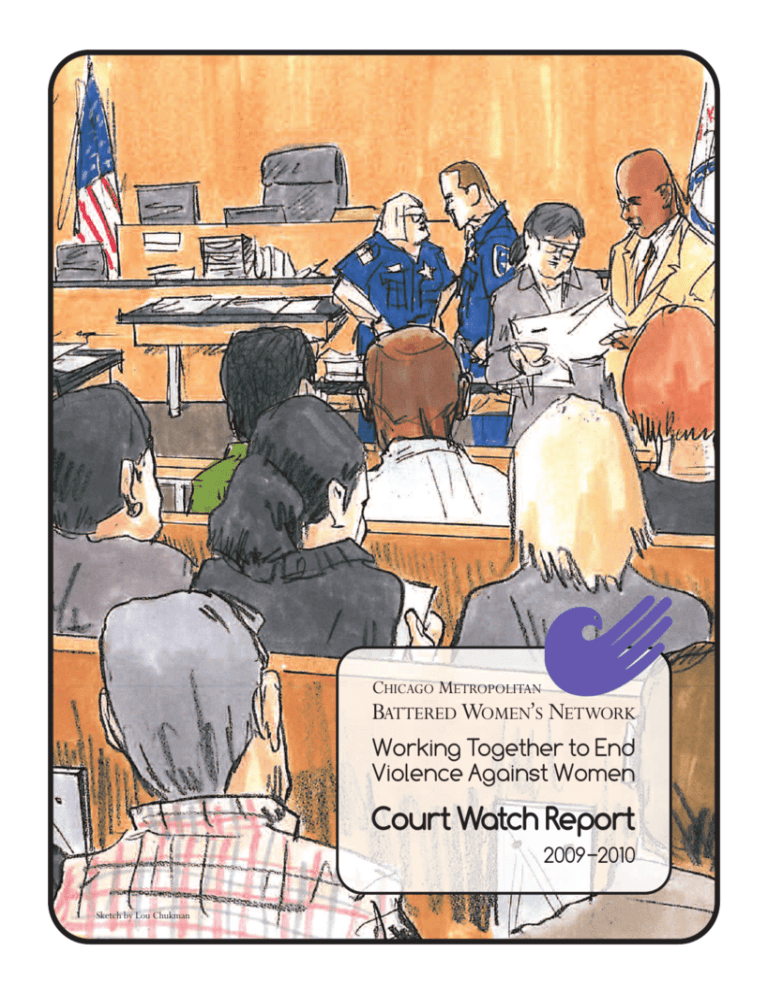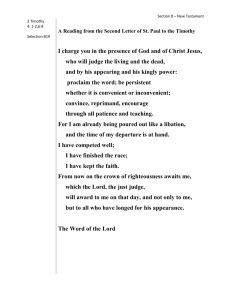
ChiCago MetropoLitan
Battered WoMen’S netWork
Working Together to End
Violence Against Women
Court Watch Report
2009−2010
Sketch by Lou Chukman
The CouRT WaTCh Mission
• increase public awareness of domestic
violence and the domestic violence laws
• encourage community involvement in
the judicial system
• promote accountability, transparency
and adherence to the illinois domestic
Violence act
the data included in this report is not a scientific
rendering by legal experts; rather, it is a qualitative
representation of a sample observed by a committed
group of community members concerned with
the accountability, transparency, and adherence to
illinois domestic Violence act by the domestic violence court and its specialized personnel. the
bulleted items below each heading on the following pages are the Court Watch volunteers’ own
words. a glossary of common abbreviations and
terms is included on the final pages of the report.
this report reflects the work of approximately 75
volunteers who collected data and made observations
throughout 380 sessions from July 2009 to June 2010.
over 2,000 cases were observed in the civil courtrooms.
another 2,400 cases were observed in the criminal
courtrooms. Volunteers were asked for their objective
observations on individual cases. Volunteers were also
asked to rate the courtesy, respect, and attitudes of
the representatives of the various court departments.
Finally, the volunteers were asked to rate the preparedness
and timeliness of the individuals being observed.
dear Friends:
i am happy to share with you the Chicago Metropolitan Battered Women’s network inaugural Court Watch project report!
allow me to give you some background information regarding the Court Watch project.
in october 2005, Cook County opened the doors to a new Centralized domestic Violence Courthouse located at 555
West harrison Street, Chicago, illinois. With this new court, many in the Chicago community hoped that in time, a
better facility would result in the advanced handling of Cook County’s domestic violence cases. however, we learned
via an article published by the Chicago tribune in october 2008 of the poor conviction rate of domestic violence cases
in Cook County (17%). in response, Chief Judge timothy evans assembled a 14-member committee to “ensure that
the Circuit Court of Cook County remains on the cutting edge in providing a safe and secure environment for the
hearing of domestic violence matters.” as executive director of Chicago Metropolitan Battered Women’s network
(the network), i was appointed to and currently sit on this committee.
as a historically strong voice for the domestic violence advocacy community, the network was already attuned to the
lack of progress at the court. therefore, when we were approached in 2008 by the illinois department of human
Services and offered the placement of a newly-created ameriCorps ViSta volunteer position to create and implement
a domestic Violence court watch program, the offer was quickly accepted. guided by the input of an advisory Council
and Steering Committee, and through the work of group of depaul law students who piloted the prototype observations
forms, the project trained its first volunteers in June 2009. Christened as the Court Watch project, the endeavor
became a special effort of the network. to date, there have been two ameriCorps ViSta Volunteers who have each
served one-year terms to create, implement and coordinate the Court Watch project, Betsy Minor and Megan V. rose.
it should be noted that in January 2010, per recommendations issued by the above mentioned committee, Judge evans
created a new domestic Violence division of the Cook County Circuit Court, which united the civil and criminal
courts hearing domestic violence cases. Under this new division efforts are currently underway to improve the court
system’s response to this specialized crime being heard in the domestic Violence Courts county-wide.
also in January 2010, a relationship was developed between the Court Watch project and Loyola University Chicago’s
Center for Urban research and Learning (CUrL). CUrL seeks to promote equality and to improve people's lives in communities throughout the Chicago metropolitan region. CUrL pursues this goal by building and supporting collaborative
research and education efforts. Such collaborations link the skills and wisdom present within every community with the
specialized knowledge and academic discipline of a vital urban university.Working together, community needs are addressed
and the academic experience is enriched. through our partnership with CUrL, data collected by Courtwatchers from
July 2009 through June 2010 was entered, synthesized, and analyzed. Made possible by a generous donation from the
Cynthia L. Bischof Memorial Foundation (www.cindysmemorial.org), this inaugural report is the result of the unpaid
efforts of many in the hopes of providing feedback to the court so that victim safety and offender accountability can be
attained.
in peace,
dawn dalton
executive director
1
inTRoduCTion
the Court Watch project is staffed by volunteers who record their observations of domestic violence
proceedings using guided forms. From the outset, volunteers are apprised that their observations are
captured for inclusion in a public report of recommendations. the Court Watch project volunteers
range from law professors to psychology students to retired persons- all with an interest in impartially
assessing the efficiency and effectiveness with which domestic violence cases are handled by the judicial
system. Volunteers participate in a training session focusing on the dynamics
of domestic violence, options and resources for victims of domestic violence
and batterers, and the relevant laws and legal processes.
interest in and community support for the Court Watch project has
been phenomenal. to date, six volunteer trainings have been held (with
a seventh planned for november 17, 2010). the pool of volunteers monitoring
the courtrooms at the City of Chicago Centralized domestic Violence Court
continues to grow. For more information regarding upcoming
trainings and/or a volunteer application, please contact
courtwatch@batteredwomensnetwork.org
if you have an experience you would
like to share regarding the court process
at 555 W. harrison, please write to
courtwatch@batteredwomensnetwork.org
and be sure to include “Court Watch” in
the subject line.
2
Sketch by Lou Chukman
The Cook CounTy CenTRalized doMesTiC
ViolenCe CouRT should Be PRePaRed To Make
Full use oF iTs exisTing ResouRCes.
On-Time:
91%
Late:
9%
Civil Court start Time
On-Time: 91% • Late: 9%
On-Time:
52%
Late:
48%
Criminal Court start Time
On-Time: 52% • Late: 48%
When the courtroom is not prepared, or takes frequent, unannounced breaks of indeterminate length, what message does that send to the individuals whose cases are scheduled?
Observations From Criminal Court
• Court started late at 9:20; judge took recess at 10:30 but didn’t say for how long – ended up
being for 30 minutes. She returned and interpreter had left so she went back into recess.
• Late to court, (judge) went to recess without saying when she was coming back.
• Judge explains to defendant in very remote, fast manner – he has waived his right to jury
or any other trial. Says she (judge) will go along with plea. how can defendant understand what
she (judge) is saying?
3
Criminal continued...
• (Judge) didn’t explain anything to
CW’s or defendants–quick in & out.
• (Judge) Very distant, spoke at breakneck
speed, using legal jargon that clients
probably could not understand.
• (Judge) very quick, many cases did not
know what was going on, very late to
court, talks like a tape recorder when
giving sentences and explanations.
• Judge admonished aSa for starting
late and for requesting so many passes.
aSas not prepared.
• thought it was disrespectful for them
(aSas) to be so unprepared.
Observations From Civil Court
• this afternoon session took longer than
the last- that was good. interesting
hearing, but it went on for an hour and
a half, which is longer than most i’ve
seen. i don’t understand why they have
a 9:30 a.m. and 10:30 a.m. call when the
afternoon session barely has more than 3
cases. the morning is so packed that
people wait for 3 hours. they could get
right in if placed in the afternoon group.
the 10:30 cases should be moved to
afternoon because they never have time
to get to them and they end up being
pushed back to the afternoon anyway.
4
Neither side (SA and Def) was prepared for any case today. Everything was pushed back for one
reason or another. Six police officers in court, and they all have to
return at a later date.
ASAs seemed behind as always. Do
ASA’s talk to any CWs before the
morning of the court appearance?
Judge had a kind demeanor, smiled,
leaned forward and asked for clarification to gain more knowledge.
The judge made good eye contact
and spoke in a pleasant tone. The
judge spoke slowly, clearly, and explained violations of DV law thoroughly. The judge took time to add
additional conditions to the
EOP specific to Petitioner’s
needs. The judge did NOT
rush through case. The judge
asked Petitioner if the time
for the next court proceeding worked for her. Judge
told her that there would be
a hearing, but didn’t state
what that entailed.
Observations Worth Commending
• Judge was very patient and clear. he repeated rules, regulations, and consequences numerous times to same
person. proceedings were very quick without lag. When recess was taken judge stayed true to time given.
• aSa #1 was prepared prior to court starting. She had all her cases laid out and she called
names making sure who was there and who was not there.
ReCoMMendaTion:
The court should utilize a full day to adequately serve the public. Balancing
a prepared caseload between morning and afternoon calls will result in
fewer breaks of indeterminate lengths and permit more attention and time
to be devoted to each case,
and will lighten the
load on all court
personnel.
Sketch by Lou Chukman
5
The dePaRTMenTs and indiViduals WoRking WiThin
The Cook CounTy CenTRalized doMesTiC
ViolenCe CouRT should CoMBine eFFoRTs FoR
CoMPRehensiVe seRViCe deliVeRy.
When existing resources are uncoordinated, unused, or made available to some but
not all, is justice achieved?
Observations From Criminal Court
• Judge pointed out a couple of issues with the Chicago
police officers regarding conversations with the CW
and one officer did not remember the CW told them
about a gun regarding dV when she called the police.
also, CW signed a blank complaint with the police
which did not include a gun and choking
complaint. the defendant was found not guilty.
• discrepancies about many details. inconsistencies
in state’s complaint and in police report. these
undermine her credibility. police officer can’t
testify because not here.
Observations From Civil Court
• told victim to get info on defendant’s arrest.
i am wondering if the judge could have
had the clerk look up arrest.
• Why aren’t indiana and illinois sheriff
offices coordinating the service of
warrants? this petitioner’s case is
delayed because indiana serves
respondents through the mail and
illinois will not accept that service so
this petitioner cannot get an alias
summons to proceed with hearing.
6
There appeared to be
a trend, where Petitioners were frustrated with
instructions given to
them by authorities (police, etc.) and what the
judge was looking for
in order to grant OPs.
Sketch by Lou Chukman
Civil Continued...
• petitioner stated that the police told her that she can only
file (for an op) between 8:30 a.m. and 1:30 p.m. this
explained the delay in filing for the op because of
petitioner’s work and school schedule (as she was not
available during those hours). Judge was concerned that
the police misinformed her.
• petitioner was sitting next to me, and respondent was one
row behind and kept trying to talk to her. it was uncomfortable.
When petitioner pulled out paperwork, respondent was
trying to look at it over her shoulder. Seems like they
should’ve been separated so respondent
couldn’t talk to petitioner before their hearing.
She [judge] suggests
to Petitioner to take
a copy of the EOP to
local police and to
always carry a copy
of the EOP
with her at all
times. Asked
Petitioner if
she had any
questions.
Very helpful
in sending her
to advocates.
Judge
and
clerk were very
good at linking
Petitioner with DV
advocate to work
with her on emancipation issues for her
sister.
Observations Worth Commending
• in a case where the respondent was just
released from jail at 2:00 p.m. (it was 2:55
p.m.), judge suggested that petitioner go to
police station now with eop and have them
accompany her back to her apartment, then
if respondent is there, he can be served.
ReCoMMendaTion:
Develop coordinated communication between law enforcement
and the courts so that expectations
for Petitioners are clear. Publicize
fantastic existing resources such
as the children’s advocacy clinic,
the victim waiting rooms with
corresponding intercom system,
and the victim safe elevator.
7
The ReCenT CReaTion oF a doMesTiC ViolenCe
diVision WiThin The Cook CounTy CiRCuiT
CouRT sysTeM ReFleCTs an ongoing need FoR
inTegRaTion oF seRViCes.
When a victim is not able to maintain an Order of Protection at the close of a criminal case,
and that victim’s ability to obtain a civil order is then compromised, how does this reflect
on the court’s effort to close the gap between victim safety and offender accountability?
Observations From Criminal Court
• perhaps it’s because the judge had heard so many
cases & seen many petitioners, she didn’t believe
their side of the story. out in the hall, the aSa
said they could file civil suit. they had injuries.
Observations From Civil Court
• petitioner must file amended petition of
alleged abuse. dropped criminal case.
hasn’t alleged abuse under the act
(idVa). needs to start again.
ReCoMMendaTion:
Encourage collaboration
between the criminal and civil
courts. Facilitate a protocol
whereby a complaining
witness in a criminal matter
can retain her Order of
Protection even if the State
elects to terminate the
criminal case.
8
Sketch by Lou Chukman
The Cook CounTy CenTRalized doMesTiC
ViolenCe CouRT aiMs To seRVe a diVeRse, uRBan
PuBliC and should haVe adequaTe sTaFF To MeeT
The needs oF This PoPulaTion.
Do the individuals using the court adequately understand what is happening? Do the
individuals using the court feel adequately understood by the players within the judicial
system? If not, how is the court preparing to meet those needs?
Observations From Civil Court
• Judge tried to convince
respondent to go forward with
hearing without Spanish
interpreter. Spanish interpreter
was tied up in hearing upstairs.
respondent did speak english
well, but this request was still
questionable.
• Court moved at a pretty good
pace. But many cases needed an
interpreter and they didn’t call for
one until halfway through the call.
ReCoMMendaTion:
Increase number of interpreters. Implement a method
to station interpreters in
one courtroom (or on one
floor) on a rotating basis so
that coverage is maximized.
9
The doMesTiC ViolenCe diVision MusT WoRk To
equiP Those WiThin The sysTeM WiTh FoundaTional
knoWledge and skill seTs To ensuRe suCCess.
What messages are being received
by victims who come to court? Will
it impact what they say about their
court experience? If needed, will
they come back again?
Observations From Criminal Court
• aSas were on Facebook on the
computer facing the gallery.
• aSa #1 talked throughout aSa #2 case.
Made smirks, rude comments, continually
commented on the case – although this
was not really “bad” dV court behavior,
it was inappropriate and distracting.
(Courtroom Personnel) Very nice
to all defendants and CWs. I was
very impressed by how all people
were treated today.
CW dropped charges.
Judge had her remove
her sunglasses and
forced Defendant to
look at her eye injury.
Told him (Defendant)
to get help.
• aSa placed a $5 bet that a defendant
would do a bench trial. is that appropriate?
• aSa made fun of CW for being gay!
Looked at other aSas and said, ‘he is just
dropping it because he is gay…’
• Lots of sustaining objections during aSa
questions and CW very difficult to understand.
aSa struggled with what questions to ask
and how (e.g. “Who was in the car?” has
to be “who, if anyone, was in the car”).
ASAs not involved in the
trial were
surfing the
internet (in
the
open
courtroom).
• Judge asked the victim why the defendant assaulted her.
• (Judge did) little to no commenting on dropped casessometimes congratulated defendant on dropped charges.
10
Observations From Civil Court
• For one case, the Judge said, “all you have to do is stay away from her, simple enough – no problem”
i think this doesn’t express the seriousness of the situation.
• Motion to vacate eop. they have reconciled and are seeking to vacate eop. Motion granted but
judge lectured them on acting like adults, not treating each other abusively or disrespectfully. (Judge
said) can’t use the courts whenever they argue, then move to dismiss. if she (petitioner) keeps coming
“crying wolf,” then the judge will stop being sympathetic to her. also talked about being good role
models for their son and if he sees them arguing it will create problems for him too.
• Judge makes lots of side comments- ex. “do you have kids?” “no? thank god.” “You two just need
to chill out.”
Observations Worth Commending
• he (judge) always told defendants
who strangled CW how serious the
charge is and how in seconds they
could have murdered someone.
also, he told all defendants that got
cases dismissed due to CW dropping charges that they could
spend one year in jail if it (the
alleged offense) occurred.
ReCoMMendaTion:
Require basic training on domestic violence dynamics. All
court staff needs to
be held to a standard
that shows the seriousness of the cases
coming into the
court.
Sketch by Lou Chukman
11
The Cook CounTy CenTRalized doMesTiC ViolenCe
CouRT is a sPeCialized CouRT oPeRaTing WiThin
The sPeCialized legislaTion oF The idVa. all
dePaRTMenTs and indiViduals Who WoRk WiThin
This sysTeM should Be TRained To Fully uTilize The
unique ReMedies aVailaBle.
When carefully crafted legislation is misused or underused, what message does that
send to perpetrators of domestic violence? What message does that send to survivors
of domestic violence?
Observations From Civil Court
• in this case, the emergency order was denied. Judge had to ask numerous questions trying to understand
the nature of their relationship. the petitioner had not been informed of the relationships that
qualify under the act. he says that they dated for 2 years but were not boyfriend/girlfriend.
So judge determined it was not a qualifying relationship. i left very confused
as to why it was not granted.
• Courtroom proceedings ran smoothly, orderly. troublesome that several
cases resolved with mutual restraining orders instead of op.
• Judge issued a mutual restraining order for one party. each person agreed to
stay away from one another since they were both accusing the other one of
harassment and threats. i am wondering how this happened because the
parties (in another case) asked for a mutual restraining order and the
judge said it wasn’t possible. So it is clear that the judge understands
mutual orders aren’t good in all circumstances but i am confused.
• petitioner presented evidence of threats by the respondent- including
voicemails. one of the voicemails clearly stated that respondent was
implying killing the petitioner – “that is how people get killed, that is
how people get on the news.” despite this evidence, the judge didn’t
grant an op. instead a mutual restraining order was entered. according to the
respondent, an op would be a violation of his probation (he was released from prison in
March after serving 4 years).
12
I found the Judge saying
things to the Petitioner that
reflected poor understanding
of domestic violence issues.
For example, “you can’t have
your cake and eat it too” in
regard to the on-again
off-again (nature of
the relationship) and
woman taking him
back.
Observations Worth Commending
• this judge is exceptional at explaining legal terms
and procedures to petitioners. the judge explains
everything including that the sheriff will try to
serve respondent and that he might appear in
court at a later date. She seems very mindful of
giving information that will educate/benefit the
petitioner.
• Very careful, thoughtful, and thorough – explains
so many terms (who is a 3rd party) – suggests
things to petitioners that are helpful: adding
school address to eop, asking landlord to change
locks, sharing eop with landlord and local police.
Judge appeared
to being paying
very close attention
to what was being
said, taking pages of
notes and referring
back to previous testimony. …Very polite
to CW when testifying…
After closing arguments, the
Judge did a good job going
over the credibility of each witness and a good explanation of
the findings (not guilty). Judge made
sure to say (to Defendant) that it
didn’t mean he was “innocent.”
Sketch by Lou Chukman
ReCoMMendaTion:
Require extensive training on
the Illinois Domestic Violence
Act including qualifying relationships, types of relief
available, situations where each
type of relief best addresses the
parties’ needs, and effective
consequences for violations of
Orders of Protection.
13
The sheeR quanTiTy oF PRo se PeTiTioneRs
deMands a MoRe TRansPaRenT PRoCess and
aCCessiBiliTy To naVigaToRs FoR CouRT
PRoCeedings, esPeCially in CiVil CouRT.
Many individuals do not have a navigator when using the court system. Court Watch
volunteers consistently identified the need for advocacy and legal services, and frequently asked why more Petitioners did not have such services.
Observations From Civil Court
• appears to be a lot of confusion and people don’t know where they need to go or what to do.
• Judge repeatedly said to petitioner “Ma’am you’re here to prove
your case” petitioner seemed confused.
• the nature of the proceeding was not explained at the
beginning, but instead as they were going, which was confusing
to both parties. Witnesses were not allowed to elaborate
but only answer questions. the respondent and petitioner
clearly are not attorneys and did not know how to ask
questions in order to get the information they wanted.
the two sides were definitely disadvantaged because they
did not have legal help or assistance. Clearly there
were cultural and language barriers present here.
• (on a scale of 1-5, with 1 being the worst) i gave the
Judge a “2” because she left the bench without saying
why, and she did not explain the proceedings to civil
parties before she started court today. in civil court
that is important because parties may not have been
in court before.
• the clerk was abrasive and expected respondents/
petitioners to completely understand what they were
supposed to do (i.e. Checking in, whether they could
bring children into the courtroom).
14
Civil Continued...
Judge: “Do you have
any questions?” Petitioner: (asked a question) Judge: “That is not
a proper question.” Petitioner: (“what can I
ask?”) Judge: “I’m not
your attorney. You’ve
chosen to represent
yourself. Any questions?”
Petitioner: (“No”).
• Must they scream? Maybe the deputies need to establish
their authority? the deputies are all crowded around the
screening area, then they yell “step down, step down!” a
suggestion is if one deputy would stand in the hallway
and tell visitors to take off their belts, turn off their cell
phones, then maybe everyone would be ready to put their
items in the baskets. also if one deputy would open the
door to the lobby and direct the public to move into the
lobby to put back on their belts.
ReCoMMendaTion:
Communicate expectations to Petitioners
and Respondents alike. Petitioners and
Respondents must know in advance
what the process requires of themfrom the minor details (ensuring
their case is not dismissed or a default
order is not entered against them)
to the major concerns (what level
of proof is needed and what types
of evidence will be relevant and
admissible). Advise what items may
not be brought to the courthouse
as well as what resources may be
available for them while they are
there so they may plan in advance.
This may be done by mailing information out along with Notices
to Appear and/or other court
correspondence.
Sketch by Lou Chukman
15
The Cook CounTy CenTRalized doMesTiC
ViolenCe CouRT should FRonT-load ResouRCes
To sTReaMline adjudiCaTion in The CouRTRooM.
When information and guidance is available at the beginning of the process, parties
are able to make more informed choices regarding case direction and relief requested.
Observations From Civil Court
• no perceived problems until somehow a petitioners’ file
was misplaced and she was told to go fill out another.
it would be highly beneficial to both the court and the
petitioner if the use of advocates were greater- especially
in the process of filing paperwork.
• in eop #3, Judge made her redo paperwork because
she did not fill it out right.
• Judge asked a lawyer who was there on another case to
sit with a different petitioner and amend petition. after
the amendment, the petition was much clearer and the
eop was granted. afterward, judge advised advocate
on what is necessary when filling out the petitions. had
they not amended, she would not have granted the eop
based on the first petition.
• in a case that was not listed on the call sheet, the petitioner
was very well spoken and had a lawyer present. the judge
allowed him to speak freely. not sure this would have
occurred if he didn’t have a lawyer or if he was less
educated, since she often interrupted other petitioners.
• the judge seemed friendlier when lawyers were present.
(the judge) became frustrated when petitioner or
respondent didn’t understand what she was saying.
• two advocates present. i noticed that petitioners who
had advocates definitely had a better sense/comfort
level with the court proceedings.
16
Sketch by Lou Chukman
This judge scratches out irrelevant/
inaccurate checked boxes on the OPs
(and explains why they’re not accurate).
This suggests that people need help
filling out these forms. One Petitioner
said she checked things that she didn’t
want to happen, not what had happened.
Inaccurate box checking happened
on almost every EOP case.
Judge scratches out areas on
OP that don’t apply (one Petitioner checked exploitation but
wasn’t over 65) and explains why
she is doing this. E.g. “I want you
to be able to testify to everything
– you’re still getting your OP.”
Civil Continued...
• For the most part, attorneys seemed to
be helpful in clarifying situations/
questioning when they were present.
however, not many clients had lawyers.
• Many cases seemed to involve custody issues
or other issues not pertinent to dV court.
i thought the Judge was effective when she
asked “What are you asking me to do?” that
clarified petitioner’s objective. however,
there was also a lot of legal talk about why
the case was not suitable for this court, and
i could see where petitioner would be
confused. especially when an interpreter
is involved. Should there be more resources
available to help petitioners navigate system?
Observations Worth Commending
• the judge was very respectful of
everyone in the courtroom. he
explained courtroom proceedings very
thoroughly. he spoke calmly and
seemed much less excitable and irritable as compared to the other judges i have seen.
ReCoMMendaTion:
Start at the beginning of the process of filing for an Order of Protection
by better guiding Petitioners. Provide assistance to help shape
their requests by creating educational materials that illustrate
the types of relief available for Petitioners under the IDVA. Create
a simple, easy-to-follow guide to assist Petitioners who do not
have one-on-one assistance. Provide model completed forms.
Show examples of incorrectly filled out forms. Devote energy
and resources to securing more help for Petitioners in the
beginning stages of the process by stationing well-trained
advocates, lawyers, and volunteers in the court’s screening area.
17
The Cook CounTy doMesTiC ViolenCe CouRT
needs a BeTTeR sCReening PRoCess To
adequaTely diReCT PRo se PeTiTioneRs seeking
VaRious TyPes oF RelieF.
Are certain cases better suited to be addressed by other courts that are familiar
with the parties and have the remedies
available to address their conflicts?
Observations From Civil Court
The judge said herself that
the courts are not a place to
turn to when a family member is acting stupid. Yet she
granted an OP for one year!
• Judge told petitioner to stop muttering under her
breath. Judge upset because this is not right forum
to discuss issues of a will for a 90-year-old. Judge
admonished respondent’s counsel for not
cooperating with petitioner’s attorney.
• house of great grandmother is in probate. Judge was mad.
• interpreter claims they want a divorce. Judge says (court) can only handle ops. Judge says they
need legal advice.
ReCoMMendaTion:
Implement a process to efficiently screen cases from outset. Utilize emergency
orders where appropriate, but direct cases that are better suited for plenary
hearings elsewhere (i.e. probate and guardianship matters) so they do not
exhaust valuable court resources and ensure litigants are being heard by
the courts best equipped to address their concerns. Mimic the approach
used with Domestic Relations cases, and consolidate matters before they
reach the plenary hearing stage.
18
glossaRy
Alias Summons:
Court document that extends the time period in which a defendant/respondent may be legally served.
Assistant State’s Attorney (ASA):
the attorney who represents the State (prosecution) in criminal proceedings.
Call sheet:
a roster of cases to be called during a court session.
Complaining Witness (CW):
the survivor/victim on whose testimony the state relies to bring its case.
Courtwatcher:
a volunteer who observes the courthouse experience for both civil and criminal court proceedings
for a report for the community.
Defendant:
the individual defending charges brought by the State.
Domestic Violence:
a pattern of physical and psychological abuse, threats, intimidation, isolation or economic coercion
used by one person to exert power and control over another person in the context of a dating, family
or household relationship.
Illinois Domestic Violence Act (IDVA):
the idVa protects domestic violence victims who have or had a relationship with their abusers, such
as: family members related by blood or marriage; current or former spouses; current or former
boyfriends or girlfriends; parents of the victims’ children; current or former roommates; and persons
residing or employed at a private home or public shelter.
Mutual Restraining Order:
a restraining order is occasionally offered as an alternative to an order of protection. to do so avoids
recognition that the parties share a domestic relationship. also, a violation of a restraining order may
be merely a civil contempt of court charge, whereas a violation of an order of protection can be
charged as a misdemeanor or a felony.
19
glossaRy ConTinued...
Petitioner (sometimes referred to as “victim” or “complaining witness” or
“CW” in the observations):
the individual seeking an order of protection in a civil case.
Pro Se:
an individual who is accessing the court system without legal representation.
Public Defender (PD):
a lawyer employed by the government to represent those who are charged with a crime and cannot
afford an attorney.
Respondent (sometimes referred to as Defendant):
the individual who is named as the offending party against whom the petitioner is seeking an order
of protection.
Order of Protection:
a court order that prohibits unwanted/abusive contact by an abuser and is only available to those with
qualifying relationships identified in the idVa. an Emergency Order of Protection (EOP) can
be obtained ex parte (without notice to the other party), and is effective for no fewer than 14 days
and no more than 21 days.
Consequences for violations:
Violating an order of protection is a Class a misdemeanor, and if found guilty, the
defendant could go to jail for up to 364 days and pay a fine. a second violation of an order
of protection (or a violation after conviction of a serious crime against a family or household
member) can be charged as a felony. if an abuser commits a second violation of order of
protection, and is found guilty, courts must sentence the abuser to 24 hours jail time and
order abuser to pay $100 domestic violence fine, unless the increased fine will impose an
undue harm on the victim of domestic violence.
For more information, including the idVa in its entirety, please visit: www.ilcadv.org
20
2009-2010 CouRT WaTCh PRojeCT
BoaRd oF
diReCToRs
adVisoRy
CounCil
sTeeRing
CoMMiTTee
officers
judge gloria Coco
Judge of the Circuit Court
of Cook County, retired
ann Brigham
Associate Professor of English
& Women's and Gender Studies,
Roosevelt University
Mary dolan, Co-Chair
aparna sen-yeldandi, Co-Chair
kathryn socha, Secretary
Michelle Rojo, Treasurer
directors
Chelsea ashbrook
jennifer gabrenya
Carol Mcguire
dorice e. Pepin
linda Pilastro
hima sarma
dina schenk
special thanks to
loyola university
Chicago’s CuRl
Wendy Cohen
Sr. Policy Advisor - Women's
Issues, Attorney General
Lisa Madigan's Office
jon F. erickson
Attorney at Law, Erickson &
Oppenheimer, P.C.
Brian Fabes, Phd
Executive Director,
Civic Consulting Alliance
sunny Fischer
Executive Director, The
Richard H. Driehaus Foundation
andie Celerio
Assistant Director, Campus
Advocacy Network, University
of Illinois at Chicago
dr. lorraine a.j. daniel
Associate Professor of
Counseling & Coordinator of
Women’s Resource Center,
Chicago State University
Robyn lynes
Law student, Kent Law School
ann Russo, Phd
DePaul University,
Women’s and Gender Studies
Betsy Minor
Policy Advocate / Project
Coordinator, Chicago
Metropolitan Battered
Women’s Network
Wendy sadler
Former President of the Board
Cook County Court Watchers
Margaret o’hara
Retired RN
Member, LWV Chicago
Charles stoops, Phd
Professor, Dominican University
Wendy sadler
Former Board President
Cook County Court Watchers
aysha shalabey
Arab American Family Services
susan stearns
Volunteer Coordinator,
Oak Park Volunteer Center
ChiCago MetropoLitan
Battered WoMen’S netWork
One E. Wacker Dr., Ste 1630 • Chicago, IL 60601
P: 312.527.0730 • F: 312.527.0733 • TTy: 312.527.0735
info@BatteredWomensNetwork.org
• www.BatteredWomensnetwork.org •
© Chicago Metropolitan Battered Women’s Network, 2010
All Rights Reserved. No part of this report may be reproduced, stored in
a retrieval system, or transmitted, in any form or by any means, electronic,
mechanical, photocopying, recording, or otherwise, without the prior written permission of the Chicago Metropolitan Battered Women’s Network.







